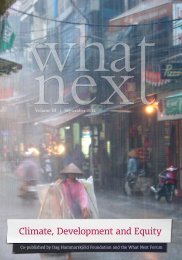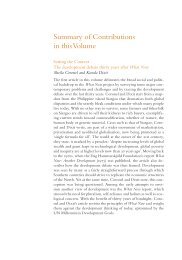- Page 1 and 2:
PRESS RELEASEContact:Linda Chiavaro
- Page 3 and 4:
ContentsEditorial note 2Chapter 1 I
- Page 5:
editorial note 3in Dorset, UK - poi
- Page 8 and 9:
6 development dialogue september 20
- Page 10 and 11:
8 development dialogue september 20
- Page 12 and 13:
10 development dialogue september 2
- Page 14 and 15:
12 development dialogue september 2
- Page 16 and 17:
14 development dialogue september 2
- Page 18 and 19:
16 development dialogue september 2
- Page 20 and 21:
18 development dialogue september 2
- Page 22 and 23:
20 development dialogue september 2
- Page 24 and 25:
22 development dialogue september 2
- Page 26 and 27:
24 development dialogue september 2
- Page 28 and 29:
26 development dialogue september 2
- Page 30 and 31:
28 development dialogue september 2
- Page 33 and 34:
Chapter 2‘Made in the USA’A sho
- Page 35 and 36:
‘made in the usa’ - a short his
- Page 37 and 38:
‘made in the usa’ - a short his
- Page 39 and 40:
‘made in the usa’ - a short his
- Page 41 and 42:
‘made in the usa’ - a short his
- Page 43 and 44:
‘made in the usa’ - a short his
- Page 45 and 46:
‘made in the usa’ - a short his
- Page 47 and 48:
‘made in the usa’ - a short his
- Page 49 and 50:
‘made in the usa’ - a short his
- Page 51 and 52:
‘made in the usa’ - a short his
- Page 53 and 54: ‘made in the usa’ - a short his
- Page 55 and 56: ‘made in the usa’ - a short his
- Page 57 and 58: ‘made in the usa’ - a short his
- Page 59 and 60: ‘made in the usa’ - a short his
- Page 61 and 62: ‘made in the usa’ - a short his
- Page 63 and 64: ‘made in the usa’ - a short his
- Page 65 and 66: ‘made in the usa’ - a short his
- Page 67 and 68: ‘made in the usa’ - a short his
- Page 69 and 70: ‘made in the usa’ - a short his
- Page 71: ‘made in the usa’ - a short his
- Page 74 and 75: 72 development dialogue september 2
- Page 76 and 77: 74 development dialogue september 2
- Page 78 and 79: 76 development dialogue september 2
- Page 80 and 81: 78 development dialogue september 2
- Page 82 and 83: 80 development dialogue september 2
- Page 84 and 85: 82 development dialogue september 2
- Page 86 and 87: 84 development dialogue september 2
- Page 88 and 89: 86 development dialogue september 2
- Page 90 and 91: 88 development dialogue september 2
- Page 92 and 93: 90 development dialogue september 2
- Page 94 and 95: 92 development dialogue september 2
- Page 96 and 97: 94 development dialogue september 2
- Page 98 and 99: 96 development dialogue september 2
- Page 100 and 101: 98 development dialogue september 2
- Page 102 and 103: 100 development dialogue september
- Page 106 and 107: 104 development dialogue september
- Page 108 and 109: 106 development dialogue september
- Page 110 and 111: 108 development dialogue september
- Page 112 and 113: 110 development dialogue september
- Page 114 and 115: 112 development dialogue september
- Page 116 and 117: 114 development dialogue september
- Page 118 and 119: 116 development dialogue september
- Page 120 and 121: 118 development dialogue september
- Page 122 and 123: 120 development dialogue september
- Page 124 and 125: 122 development dialogue september
- Page 126 and 127: 124 development dialogue september
- Page 128 and 129: 126 development dialogue september
- Page 130 and 131: 128 development dialogue september
- Page 132 and 133: 130 development dialogue september
- Page 134 and 135: 132 development dialogue september
- Page 136 and 137: 134 development dialogue september
- Page 138 and 139: 136 development dialogue september
- Page 140 and 141: 138 development dialogue september
- Page 142 and 143: 140 development dialogue september
- Page 144 and 145: 142 development dialogue september
- Page 146 and 147: 144 development dialogue september
- Page 148 and 149: 146 development dialogue september
- Page 150 and 151: 148 development dialogue september
- Page 152 and 153: 150 development dialogue september
- Page 154 and 155:
152 development dialogue september
- Page 156 and 157:
154 development dialogue september
- Page 158 and 159:
156 development dialogue september
- Page 160 and 161:
158 development dialogue september
- Page 162 and 163:
160 development dialogue september
- Page 164 and 165:
162 development dialogue september
- Page 166 and 167:
164 development dialogue september
- Page 168 and 169:
166 development dialogue september
- Page 170 and 171:
168 development dialogue september
- Page 172 and 173:
170 development dialogue september
- Page 174 and 175:
172 development dialogue september
- Page 176 and 177:
174 development dialogue september
- Page 178 and 179:
176 development dialogue september
- Page 180 and 181:
178 development dialogue september
- Page 182 and 183:
180 development dialogue september
- Page 184 and 185:
182 development dialogue september
- Page 186 and 187:
184 development dialogue september
- Page 188 and 189:
186 development dialogue september
- Page 190 and 191:
188 development dialogue september
- Page 192 and 193:
190 development dialogue september
- Page 194 and 195:
192 development dialogue september
- Page 196 and 197:
194 development dialogue september
- Page 198 and 199:
196 development dialogue september
- Page 200 and 201:
198 development dialogue september
- Page 202 and 203:
200 development dialogue september
- Page 204 and 205:
202 development dialogue september
- Page 206 and 207:
204 development dialogue september
- Page 208 and 209:
206 development dialogue september
- Page 210 and 211:
208 development dialogue september
- Page 212 and 213:
210 development dialogue september
- Page 214 and 215:
212 development dialogue september
- Page 216 and 217:
214 development dialogue september
- Page 218:
216 development dialogue september
- Page 222 and 223:
220 development dialogue september
- Page 224 and 225:
222 development dialogue september
- Page 226 and 227:
224 development dialogue september
- Page 228 and 229:
226 development dialogue september
- Page 230 and 231:
228 development dialogue september
- Page 232 and 233:
230 development dialogue september
- Page 234 and 235:
232 development dialogue september
- Page 236 and 237:
234 development dialogue september
- Page 238 and 239:
236 development dialogue september
- Page 240 and 241:
238 development dialogue september
- Page 242 and 243:
240 development dialogue september
- Page 244 and 245:
242 development dialogue september
- Page 246 and 247:
244 development dialogue september
- Page 248 and 249:
246 development dialogue september
- Page 250 and 251:
248 development dialogue september
- Page 252 and 253:
250 development dialogue september
- Page 254 and 255:
252 development dialogue september
- Page 256 and 257:
254 development dialogue september
- Page 258 and 259:
256 development dialogue september
- Page 260 and 261:
258 development dialogue september
- Page 262 and 263:
260 development dialogue september
- Page 264 and 265:
262 development dialogue september
- Page 266 and 267:
264 development dialogue september
- Page 268 and 269:
266 development dialogue september
- Page 270 and 271:
268 development dialogue september
- Page 272 and 273:
270 development dialogue september
- Page 274 and 275:
272 development dialogue september
- Page 276 and 277:
274 development dialogue september
- Page 278 and 279:
276 development dialogue september
- Page 280 and 281:
278 development dialogue september
- Page 282 and 283:
280 development dialogue september
- Page 284 and 285:
282 development dialogue september
- Page 286 and 287:
284 development dialogue september
- Page 288 and 289:
286 development dialogue september
- Page 290 and 291:
288 development dialogue september
- Page 292 and 293:
290 development dialogue september
- Page 294 and 295:
292 development dialogue september
- Page 296 and 297:
294 development dialogue september
- Page 298 and 299:
296 development dialogue september
- Page 300 and 301:
298 development dialogue september
- Page 302 and 303:
300 development dialogue september
- Page 304 and 305:
302 development dialogue september
- Page 306 and 307:
304 development dialogue september
- Page 308 and 309:
306 development dialogue september
- Page 310 and 311:
308 development dialogue september
- Page 312 and 313:
310 development dialogue september
- Page 314 and 315:
312 development dialogue september
- Page 316 and 317:
314 development dialogue september
- Page 318 and 319:
316 development dialogue september
- Page 320 and 321:
318 development dialogue september
- Page 322 and 323:
320 development dialogue september
- Page 324 and 325:
322 development dialogue september
- Page 326 and 327:
324 development dialogue september
- Page 328 and 329:
326 development dialogue september
- Page 331 and 332:
Chapter 5Ways forwardIn which the c
- Page 333 and 334:
ways forward 331‘Tinkering around
- Page 335 and 336:
ways forward 333suggests that the
- Page 337 and 338:
ways forward 335more stringent than
- Page 339 and 340:
ways forward 337Unlike carbon tradi
- Page 341 and 342:
ways forward 339hold little appeal
- Page 343 and 344:
ways forward 341Waiting their Chanc
- Page 345 and 346:
ways forward 343ways - many of whic
- Page 347 and 348:
ways forward 345energy - loan benef
- Page 349 and 350:
ways forward 347From an Open Letter
- Page 351 and 352:
ways forward 349be answered in the
- Page 353 and 354:
ways forward 351rogated by Indian v
- Page 355 and 356:
ways forward 353argue, they’ve he
- Page 357 and 358:
ways forward 355‘The US alone acc
- Page 359 and 360:
appendix - the durban declaration o
- Page 361 and 362:
appendix - the durban declaration o





